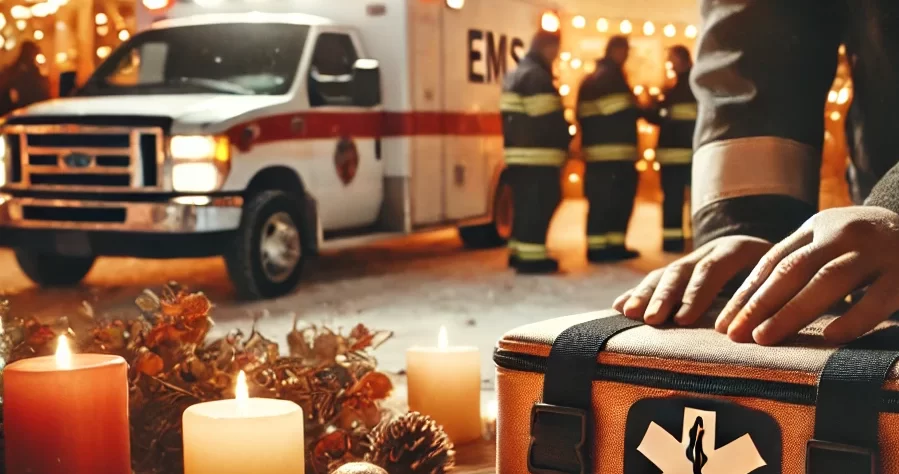Holiday gatherings are a wonderful time to connect with loved ones, yet they also bring risks. With more people in one place, the chance of accidents and health emergencies increases. Common issues include falls, burns, and sudden health episodes, especially among older family members. EMS and first aid preparedness are vital during these events. They ensure everyone enjoys the holiday season safely and responsibly.
Unique Risks During the Holiday Season
Holiday-Related Injuries and Accidents
Decorating and cooking become major activities during the holidays, raising injury risks. Falls from ladders or chairs while decorating are common and can cause fractures or head injuries. Burns happen often, especially from hot stoves, ovens, or candles. Also, small ornaments or toys present choking hazards, particularly for young children. Being prepared helps prevent these incidents.
Health Emergencies for Older Adults
Older adults face heightened health risks during the holidays due to seasonal stress, cold weather, and dietary changes. Heart issues are a serious concern, especially when meals are rich, and rest is limited. Pre-existing conditions, such as diabetes or hypertension, may worsen with high-sugar, high-sodium holiday treats. Monitoring and moderating can help avoid emergencies.
Traffic and Travel Risks
Traveling over the holidays adds to the season’s risks, especially with winter weather and crowded roads. Drowsy or impaired driving poses real dangers to travelers. EMS teams experience increased calls related to traffic accidents and DUIs. Simple precautions like a designated driver or avoiding late-night drives can help keep travel safer.
Preparing for Holiday Emergencies at Home
Stocking a First Aid Kit
A holiday-specific first aid kit can help you handle minor injuries quickly. Include basic items like adhesive bandages, sterile gauze, antiseptic wipes, and a thermometer. Holiday-specific additions, such as burn ointment and extra gloves, are also wise choices. Regularly check expiration dates and keep the kit accessible for easy access.
Safety Equipment for Decorating
Holiday decorations bring joy, but they also require safe handling. When decorating high spaces, ensure ladders are stable and have someone nearby to assist. Always inspect lights for frayed wires, which pose fire risks. Additionally, wear gloves to handle any sharp objects like ornaments or hooks.
Fire Safety and Electrical Hazards
Fire risks increase with Christmas lights, candles, and real or artificial trees. Avoid placing candles near flammable items and extinguish them when leaving the room. Watering real trees daily reduces their fire hazard, while artificial trees should be fire-resistant. Turn off holiday lights before bedtime to reduce fire risks.
This chart below outlines essential safety information to help manage potential risks during holiday gatherings. Each category provides quick, practical guidance that can be followed to ensure a safer, healthier holiday season.
| Safety Area | Tips & Recommendations |
|---|---|
| Decorating Safely | Use stable ladders; keep decorations and lights away from flammable materials; inspect for damages. |
| Kitchen Safety | Supervise stoves and open flames; avoid rushing; keep children away from hot surfaces. |
| Emergency Contacts | List emergency numbers; identify nearby medical facilities; create a family emergency contact list. |
| First Aid Kit | Stock bandages, antiseptics, burn ointment, gloves, and a thermometer; check expiration dates regularly. |
| Childproofing Decor | Place breakable or small items out of reach; avoid decorations with button batteries or small parts. |
| Fire and Electrical Safety | Turn off lights before bed; water real trees regularly; keep candles away from curtains or paper. |
Supporting Family Members with Special Needs
Considerations for the Elderly
Older family members require special care to prevent overexertion and health issues. Allow them time to rest and monitor their food intake, especially with sweets or alcohol. Many elderly people take medications, so avoid mixing them with foods that may cause side effects. These small steps go a long way in safeguarding their health.
Childproofing the Holiday Environment
Children are naturally curious, especially around holiday decorations. Place sharp or fragile decorations out of their reach to avoid cuts or ingestion. Remove small items that pose choking risks, like button batteries or small toy parts. Supervision and awareness can prevent most holiday hazards.
Role of EMS and First Responders
Key EMS Responsibilities During Holidays
EMS teams prepare for holiday emergencies that may involve falls, burns, or sudden health issues. They provide critical care on-site, often stabilizing injuries until further treatment is available. Increased EMS demand means they need to respond efficiently to keep up with seasonal risks.
Mental Health and Well-being of EMS Professionals
EMS workers experience high stress due to increased demands during the holidays. Supporting their mental health helps them remain effective on duty. Peer support systems, mental resilience training, and workplace resources all contribute to their well-being. You can help by recognizing their hard work and offering encouragement.
3 Practical Tips to Enhance Holiday Safety
- Keep an Updated Contact List: Include emergency numbers and a nearby family contact for fast access in a crisis.
- Establish a Family Safety Plan: Decide who will take charge if an emergency occurs while EMS is on the way.
- Use Age-Appropriate Gifts and Decorations: Choose gifts and decorations that avoid choking, cuts, or fire hazards for children and older adults.
Frequently Asked Questions (FAQ)
- What items should be in a holiday-specific first aid kit?
Include basic items like bandages, antiseptics, burn ointment, and a thermometer. Check expiration dates regularly. - How can I safely decorate my home without risking falls or injuries?
Use stable ladders, inspect decorations for damage, and keep breakable items out of reach from kids. - What are the key signs of a heart emergency I should watch for?
Look for chest pain, shortness of breath, and sudden weakness. Seek immediate help if these signs appear. - How can EMS professionals handle mental health challenges during the holidays?
They can lean on peer support, access resilience training, and use workplace mental health resources. More details are available at emsricky.com.
Wrapping Up: A Safer Holiday Season for All
Preparedness and awareness make holiday gatherings both safe and enjoyable. EMS and first aid practices provide vital support to families, especially when risks are high. Keep safety in mind to create a memorable season filled with joy and peace.
References
EMS Safety Practices
This guide from the U.S. Fire Administration offers essential tips for developing a strong culture of EMS safety during the holidays. It covers best practices that can reduce injury risks and enhance emergency response.
EMS Safety PracticesHoliday Workplace Safety
OSHA provides comprehensive advice for holiday-related workplace safety. These guidelines can help prevent injuries related to retail, delivery, and other seasonal activities.
Holiday Workplace SafetyEmergency Medical Care in Oregon
The Oregon Health Authority’s EMS and Trauma Systems page details emergency medical care best practices, providing insights into EMS readiness and safety protocols.
Emergency Medical Care in Oregon
Jeromy VanderMeulen is a seasoned fire service leader with over two decades of experience in emergency response, training, and public safety management. He currently serves as Battalion Chief at the Lehigh Acres Fire Control & Rescue District and is CEO of the Ricky Rescue Training Academy, a premier provider of online and blended EMT and firefighter certification programs in Florida.
Jeromy holds multiple degrees from Edison State College and the Community College of the Air Force, and is pursuing his MBA at Barry University. He maintains top-tier certifications, including Fire Officer IV, Fire Instructor III, and Fire Inspector II, and has served as a subject matter expert for a court case. He is a member or the Florida Fire Chiefs Association.
Jeromy also contributes to state-level fire safety regulation and serves on several hiring and promotional boards.

